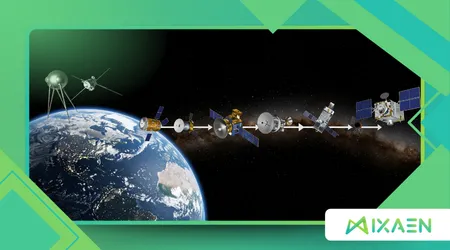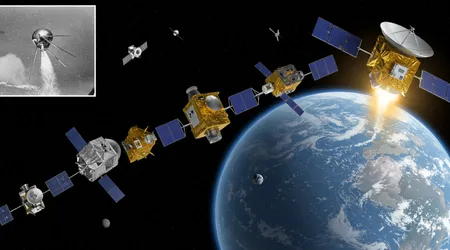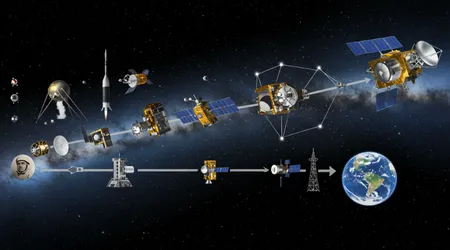From Sputnik to Starlink: The Evolution of Satellite Missions

From Sputnik to Starlink, the journey of satellite technology has reshaped humanity’s reach into space and connectivity on Earth.
Anúncios
In 1957, a small, beeping sphere named Sputnik 1 launched the space age, igniting a global race to the cosmos.
Today, SpaceX’s Starlink constellation, with over 8,000 satellites in low Earth orbit (LEO) as of August 2025, delivers high-speed internet to millions. This transformation reflects not just technological leaps but a shift in purpose from Cold War prestige to universal connectivity.
What does it mean for a world once captivated by a single satellite to now rely on thousands for daily communication?
This article explores the milestones, innovations, and implications of satellite missions, weaving a narrative of ambition, ingenuity, and global impact.
The story begins with a spark of competition and ends with a web of connectivity. Satellites have evolved from symbols of national power to tools for global unity.
This exploration traces their path, highlighting key moments, challenges, and the future of space-based systems.
We’ll dive into the technological, political, and societal shifts, offering a clear, engaging look at how satellites have redefined our world.
The Dawn of the Space Age: Sputnik’s Legacy
The Soviet Union’s Sputnik 1, launched on October 4, 1957, was a modest 83.6-kilogram aluminum ball. Its radio pulses stunned the world.
This milestone triggered the U.S.-Soviet space race, birthing NASA and accelerating technological innovation. Sputnik’s simplicity belied its impact, proving satellites could orbit Earth and transmit data.
Beyond prestige, Sputnik laid the groundwork for modern satellite applications. Early satellites like Explorer 1, launched by the U.S. in 1958, studied cosmic rays.
These missions showed satellites could gather scientific data, paving the way for weather monitoring and reconnaissance. The space race was a crucible for innovation.
++ The Moon Landing Hoax Debate: Why It Still Exists Today
Sputnik’s beeps were like a starting gun for global competition. Nations raced to deploy satellites for communication and surveillance.
By the 1960s, Telstar enabled the first transatlantic TV broadcasts. These early steps revealed satellites’ potential to connect distant corners of the globe.

The Rise of Communication Satellites: Bridging Continents
The 1960s saw satellites transform global communication. Telstar 1, launched in 1962, relayed live television across oceans.
Geostationary satellites, orbiting at 35,786 kilometers, became critical for consistent signals. They enabled real-time global broadcasts, shrinking the world.
By the 1980s, satellites like Intelsat supported international phone calls and TV networks. Their high orbits ensured broad coverage but introduced latency issues.
These systems were costly, limiting access to wealthier nations and corporations. Still, they laid the foundation for today’s connectivity.
Also read: Soviet Space Pioneers: Revisiting the Space Race from the East
Imagine a world where a single phone call across continents was a luxury. Satellites changed that, making global communication routine. However, their high costs and latency spurred innovation, setting the stage for From Sputnik to Starlink and the LEO revolution.
Communication satellites also empowered developing nations. Countries like India used INSAT systems for education and telemedicine.
These missions showed satellites could address societal needs, not just military or commercial goals. The seeds of accessibility were planted.
The GPS Revolution: Navigating the Modern World
In the 1970s, the U.S. Department of Defense launched the Global Positioning System (GPS). By 1995, 24 satellites enabled precise navigation worldwide.
GPS transformed industries, from aviation to logistics, with an economic impact valued at $1.4 trillion in the U.S. alone by 2019.
GPS satellites, orbiting at 20,200 kilometers, provided accuracy within meters. Civilian access, initially limited, became widespread by the 2000s.
Today, GPS guides everything from smartphones to autonomous vehicles, illustrating satellites’ integration into daily life.
Rea more: What the Artemis Program Could Mean for the Future of Humanity
Consider a farmer using GPS to optimize crop yields. This technology, born from military needs, now supports precision agriculture. It’s a testament to how satellite missions evolve to serve broader purposes, a theme echoed in From Sputnik to Starlink.
Other nations followed suit. China’s BeiDou, completed in 2020 with 35 satellites, rivals GPS. Russia’s GLONASS and Europe’s Galileo expanded global navigation options. These systems highlight satellites’ role in fostering both competition and cooperation.
The Low Earth Orbit Boom: Starlink’s Emergence
Enter From Sputnik to Starlink, where SpaceX’s vision redefined satellite missions. As of August 2025, Starlink operates over 8,000 LEO satellites, delivering internet with 25-millisecond latency.
Unlike geostationary satellites, LEO systems offer faster, more accessible connectivity.
Starlink’s satellites, at 550 kilometers, use laser communication for a global internet mesh. Each Falcon 9 launch deploys dozens, leveraging reusable rockets to cut costs. This scalability has connected over 5 million users worldwide by February 2025.
Picture a remote village streaming educational content. Starlink’s reach makes this possible, narrowing the digital divide. Yet, its dominance raises concerns about orbital congestion and astronomical interference, challenges Sputnik’s pioneers never imagined.
The LEO boom isn’t just SpaceX. Amazon’s Project Kuiper and OneWeb plan thousands of satellites. China’s Guowang aims for 13,000 by 2030.
This rush underscores the shift from government-led to commercial satellite missions, a defining trait of From Sputnik to Starlink.
Challenges and Controversies: The Crowded Skies
With great innovation comes great responsibility. Starlink’s 8,094 satellites (as of August 2025) comprise 65% of active satellites, raising collision risks.
Astronomers warn that satellite streaks disrupt observations, threatening scientific discovery. SpaceX has tested anti-reflective coatings to mitigate this.
Orbital debris is another issue. Starlink satellites are designed to deorbit after five years, but the sheer volume challenges space traffic management.
NASA’s Starling 1.5 experiment with SpaceX in 2025 showed automated collision avoidance is possible.
The skies are like a cosmic highway, increasingly congested. Without global coordination, collisions could cascade, creating debris clouds. This risk underscores the need for international regulations, a far cry from Sputnik’s solitary orbit.
Geopolitical tensions also arise. China and Russia view Starlink as a U.S. military asset, especially after its role in Ukraine.
A 2025 report noted their counterspace capabilities targeting Starlink, highlighting satellites’ strategic importance.
The Future of Satellite Missions: Beyond Connectivity

What’s next for From Sputnik to Starlink? Quantum communication satellites, like China’s Mozi, promise ultra-secure data transmission.
AI-driven satellites could autonomously manage orbits, reducing human oversight. These innovations push boundaries beyond internet access.
Lunar and planetary exploration will rely on satellites. NASA’s CLPS program, with $176.7 million awarded to Firefly Aerospace in 2025, aims to deliver rovers to the Moon. Satellites will support navigation and communication for these missions.
Commercial players are diversifying. Starshield, SpaceX’s military-focused constellation, enhances national security applications.
Meanwhile, satellite IoT services grew 23% in 2024, supporting industries like maritime and agriculture. The future is multifaceted.
Imagine satellites monitoring climate change in real-time, guiding disaster response. This vision builds on From Sputnik to Starlink, where satellites evolve from tools of exploration to guardians of Earth’s future, blending science and service.
Table: Key Milestones in Satellite Evolution
| Year | Mission | Achievement | Impact |
|---|---|---|---|
| 1957 | Sputnik 1 | First satellite launched | Sparked space race |
| 1962 | Telstar 1 | First transatlantic TV broadcast | Global communication |
| 1995 | GPS | Full operational capability | Navigation revolution |
| 2019 | Starlink | First LEO satellites launched | Global internet access |
| 2025 | Starling 1.5 | Automated collision avoidance | Enhanced space safety |
Conclusion
From Sputnik to Starlink, satellites have evolved from Cold War symbols to indispensable tools for connectivity, navigation, and exploration.
Sputnik’s lone beeps inspired a race that led to GPS, global broadcasts, and now, Starlink’s internet revolution.
With 8,094 satellites in orbit by August 2025, SpaceX has redefined accessibility, yet challenges like debris and geopolitical tensions loom.
The future promises quantum communication, AI-driven orbits, and lunar support, blending science with societal good.
As we gaze upward, satellites remind us of humanity’s drive to connect and explore. Will we harness their potential responsibly to shape a better future? The cosmos awaits our answer.
Frequently Asked Questions
Q: How do Starlink satellites differ from earlier satellites like Sputnik?
A: Sputnik was a single, simple satellite for radio signaling, while Starlink’s thousands of LEO satellites provide high-speed internet with low latency.
Q: What are the main concerns with Starlink’s constellation?
A: Orbital congestion, collision risks, and astronomical interference are key issues, though SpaceX mitigates these with deorbiting and anti-reflective coatings.
Q: Can satellites like Starlink support climate monitoring?
A: Yes, future satellites could use AI to monitor climate patterns in real-time, aiding disaster response and environmental management.
